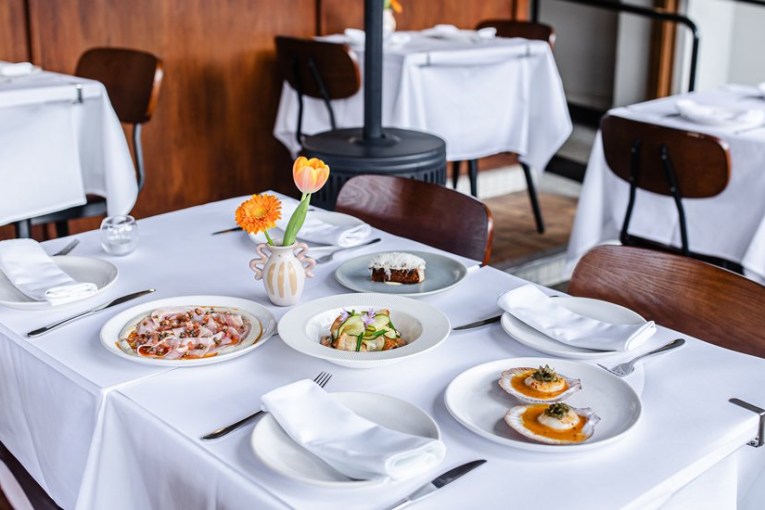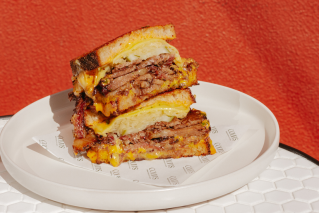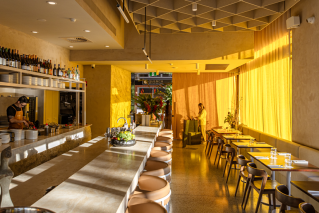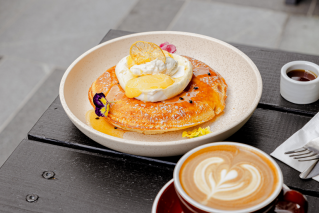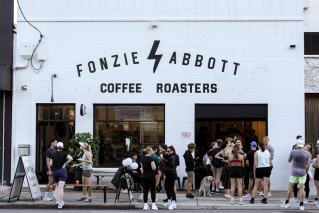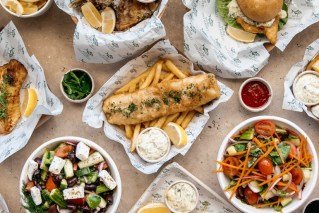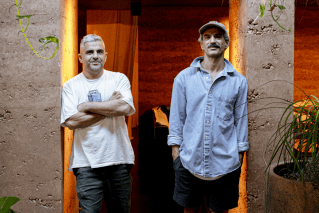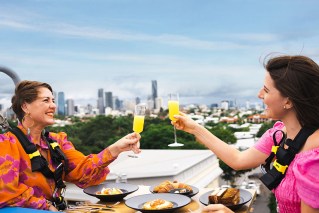Queensland’s restaurant royalty: A deep dive into the life and times of Gerard’s
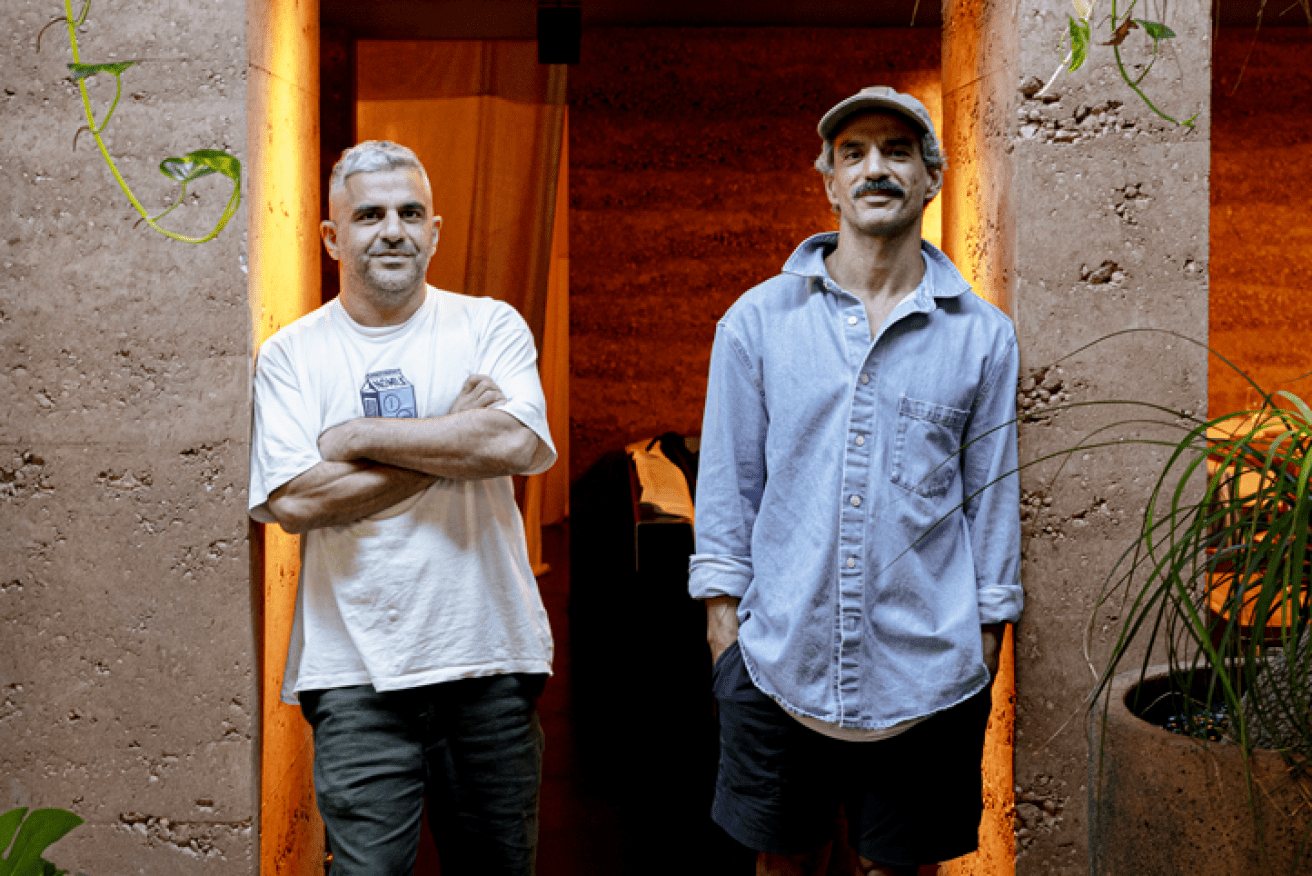
“There’s a story with everything.”
That’s Johnny Moubarak talking, one half of the sibling pairing behind Gerard’s – the pioneering Middle Eastern-inspired restaurant considered by many to be one of Brisbane’s preeminent dining institutions.
I’m sat with Johnny and his older brother Elie in Gerard’s main dining area, the heart of their warmth-filled Fortitude Valley restaurant. Gerard’s is starting an exciting chapter this year, with a refreshed look and a newly appointed executive chef at the helm. Both of these new elements arrived at a time when the local dining scene – especially the area around James Street, Gerard’s long-time home – is drawing more outside attention than it ever has.
At this point of our chat, Johnny is talking about the importance of narrative. As a filmmaker and a restaurateur, he’s is keenly aware that there’s a tale behind everything and that sometimes knowing what has come before is crucially important to properly understanding the present moment.
Ask either of the Moubaraks and they’ll likely tell you that Gerard’s current status as a bona fide Brisbane dining institution is the result of a process that started long before the restaurant ever sat a single patron. One could argue that, in fact, the story stretches back hundreds, if not thousands of years.
The rammed-earth walls that surround us – signature aspects of the recent Jared Webb-designed refurbishment – are inspired by the ancient temples of the Levant. These sturdy pillars are a nod to both the geographical region from where the Moubaraks trace their heritage, and the origins of the cuisine that they helped popularise in Brisbane when Gerard’s opened, back in 2012.
I come to realise around this part of the interview that talking about Gerard’s – even from its opening day – puts us (to use a term Johnny might apply in filmic analysis) in media res. To truly find out how Gerard’s came to be and how it evolved, you’ve got to rewind the tape a bit further.
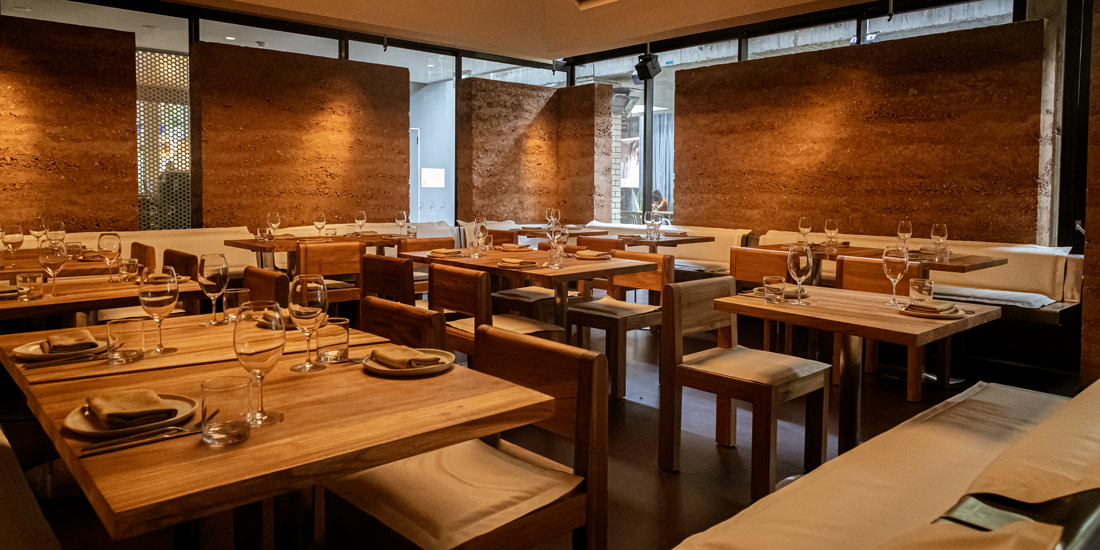
While Elie and Johnny are central characters in the Gerard’s story, perhaps one of the most influential figures in the restaurant’s narrative is their mother, Salwa Moubarak. Elie and Johnny credit the family matriarch as the person that helped instil in them an affinity for hospitality – not in the conventional restaurant operations sense, but more in the act of being generous and welcoming to others.
“Still to this day, no one is more hospitable, or knows hospitality like our mother,” says Johnny. “She’s got this personality and this presence.”
“It’s like a gravitational force,” adds Elie.
If the origins of Gerard’s can be most confidently traced anywhere, it’s to the family kitchen, where Salwa’s cooking shaped Elie and Johnny’s understanding of flavour and the importance of being open-handed.
Woven into Salwa’s Rolodex of traditional Lebanese recipes – vital pieces of generational knowledge passed down to Salwa by her own mother – was the primordial material that would eventually evolve into Gerard’s culinary offering. The fundamental building blocks of inspiration were there early, but it would still be a few years until all of those early lessons would be applied in a restaurant setting.
Elie and Johnny entered the hospitality industry back in 1999, when Elie took over storied West End bar Lychee Lounge. Known then for its eclectic decor (anyone else remember the doll-head chandeliers?) and its boundary-pushing cocktails, Lychee Lounge was a place where aesthetics and offering earned equal attention.
Once Johnny joined the fold, the duo established itself as an up-and-coming force in Brisbane’s nascent cocktail-bar scene. Each brother brought something essential to the table – Elie, with his creative direction, and Johnny with his sharp focus on the minutiae, a division of responsibility that the brothers have maintained over the past 24 years.
“[Elie] was more the leader in regards to the culture of our hospitality family and the way we operate and do things,” says Johnny. “He led the creative side – the culture and the traditions of hospitality – whereas I came along and did a bit of the more heavy lifting in regards to operations, business and back-end side of it.
“We learned everything we know from there – that’s where it all started,” he adds. “Although hospitality is inherently in our blood from our mother and our culture, Lychee Lounge was where we first really understood the professional side of it, how we service people and some of the traditions of hospitality.”
In addition to being a necessary proving ground for the duo, Lychee Lounge was also where Elie and Johnny’s hospitality ethos coalesced and morphed into an all-encompassing obsession – one that has remained a driving force in the group’s operative scheme ever since.
“You look at hospitality and you almost take it for granted – but when you get into it, it’s almost like a drug,” Johnny reveals. “You become obsessed with it and you love it and then you hate it and then you love it again. It’s drugs. It’s addiction. There’s an ego.”
Like most potent obsessions, Johnny and Elie’s fixation ratcheted up in intensity as the years progressed. In 2009 the duo opened Laruche on Ann Street, an artfully rendered split-level bar and supper club famed for its macabre Art Nouveau-inspired interiors as much as its cocktails.
The team quickly established the venue as a go-to party spot – a heaving haunt at the heart of the crowded Fortitude Valley entertainment precinct. The success of Laruche proved that the Moubaraks weren’t one-hit wonders. But as it turned out, the gang’s greatest hit was yet to be penned.
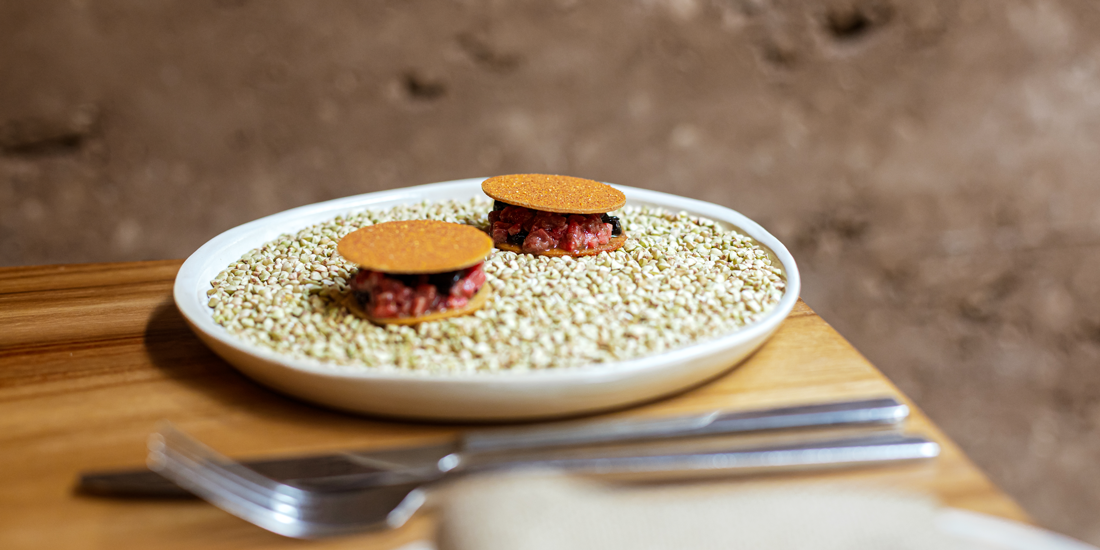
In the early 2010s, the brothers began to think about next steps. Their beloved nightlife venues were now fixtures of the scene, so, where to from here? It was at this point that Johnny and Elie decided to take a big swing. Well, perhaps a series of big swings. First, the brothers decided to get into the dining scene, but not just any kind of dining – something elevated.
“We wanted to do fine dining, but we didn’t necessarily want to do all of this,” say Johnny, gesturing to our surrounds. “We always wanted to do something Middle Eastern, but we were just unsure, because restaurant dining wasn’t our thing. We were more in bars and cocktails – drink was everything for us.”
“Gerard’s was a little bit scarier for us, because it was restaurant dining – a semi high-end kind of thing,” adds Elie. “We’d never done something like that before and that was quite challenging.”
The second big swing was the cuisine. Middle Eastern cuisine, while not a wholly unfamiliar concept in Brisbane at the time, sat more on the fringes of the city’s culinary milieu. While Middle Eastern-inspired fine dining was catching on down south, it was still a relative anomaly here in 2012. What’s more, share-style cuisine – something that was the norm at the Moubarak household, as it is in homes all across the Levant – was rare in elevated settings.
“I think at its origin, the idea of Gerard’s was to create a formal offering, because there was nothing like that with this type of cuisine in Brisbane at the time,” says Johnny. “This was 12, 13 years ago – everything was still entree, main and dessert.”
Gerard’s location was the third big swing. Back in 2012, the area around James Street was burgeoning, but a far cry from what it would become. There was no world-famous hotel, and only a handful of pioneering operators had established themselves in the relatively new precinct – one that only a few years prior was home to service stations, takeaway kiosks and the old Coca-Cola bottling plant.
But there was something about James Street that appealed to the Elie specifically – something that whispered to him and hinted at the evolution that was set to take place.
“I just felt there was something going on and I knew speaking to some property owners that there was a vision,” says Elie. “There was something brewing and it was beautiful. Of course we can see it now, but back then there was just a gut feeling, an instinct that I pushed and it ended up working.”
“You could see that there was something, there was a little sparkle there,” recalls Johnny, who also admits he was initially sceptical of the move. “We saw that Cru Bar and the James Street food markets were doing really well.”
And so the stage was set. A pair of bar owners were primed to make the jump into high-end restaurant dining, with a menu of unfamiliar cuisine and an inconspicuous location with no street frontage at the heart of a fledgling precinct. In an industry already fraught with risk, Elie and Johnny were taking a particularly perilous gamble.
“We were big risk takers,” admits Elie.
“Oh man, it was big,” agrees Johnny.
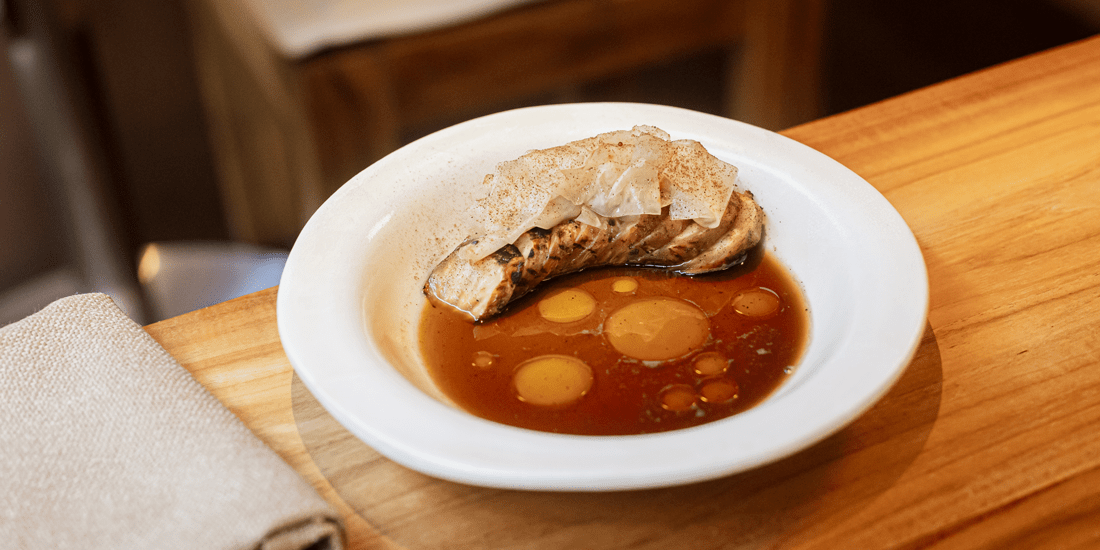
Of course, you wouldn’t be reading this article 12 years on if Gerard’s didn’t succeed. Elie and Johnny’s gamble clearly paid off, but not without a few wobbly periods. As with any restaurant finding its footing, there’s a necessary period of fine-tuning.
Elie informs me that Gerard’s wasn’t a success from day one, despite looking the goods. The trick was in figuring out a way to make its menu something that was both exciting, but approachable. Alongside Ben Williamson (who, fresh from a stint working for Gulf Air in Bahrain, joined Gerard’s as its first head chef), the restaurant’s brains trust tinkered with the Middle Eastern-meets-Mediterranean formula again and again until they were satisfied.
Naturally, Salwa – who in those days could often be found in the kitchen kneading hundreds serves of saj before service – was an important sounding board for all involved. “She held a wealth of knowledge,” says Johnny. “She was the database for our chefs in the beginning, and for us as well.”
No doubt there was an unspoken pressure to get it right. Johnny’s meticulousness and Elie’s desire to unravel the creativity at the heart of Levantine cuisine wouldn’t allow for anything less.
“When it’s your own cuisine, you’re the most critical of yourself and what you do than anyone,” says Johnny.
“We were never stagnant – we were very nimble,” adds Elie. “We did things and they didn’t work out. But we pushed through. We were always trying to figure it out.”
But, eventually, Gerard’s settled into a groove and Brisbane diners started to catch on. Spicy sujuk, smoked Murray cod with almond foam, roasted heirloom vegetables with spiced crumble, anchovy and shanklish, and saltbush lamb tagine – soon these dishes were the talk of the town.
In 2012, before Instagram and TikTok pushed new venues into the spotlight mere days after they opened, word of mouth was a potent form of marketing. When word started to spread, Johnny and Elie were surprised at the adventurousness of its earliest guests, a trend that subverted the long-held belief that Brisbane was just a big country town.
Soon, Gerard’s was racking up awards left and right, joining the likes of Esquire and Urbane as part of a crop of new-wave venues pushing Brisbane’s dining scene in progressive and exciting directions. A few years later, Gerard’s expanded with its own cocktail-centric bar offshoot, which has evolved into a destination in its own right.
Any seasoned restaurateur will tell you that it takes more than just good food to persevere in the hospitality industry – there are a few intangible qualities often at play that reveal themselves as our conversation deepens.
For the Moubaraks, it seems that the aforementioned obsession that ensnared the brothers in the early 2000s has only increased in potency as time has worn on. You can hear it in Johnny’s near-fanatical take on service, for example.
“If someone comes into my house and they leave upset, it kills me,” says Johnny. “That’s a deeply cultural thing. If people come into our business and leave upset, I become an animal. I’m mad. I’m so disappointed and sad. People say don’t take it personally, but I can’t help it – it’s hard not to.”
You can also sense it when the brothers talk about culture and team building.
“We consider everyone – from the dishie to the head chef – the same,” says Elie, who recalls often taking on cleaning duties at Laruche when the downstairs toilets flooded. “You’ve got to really see everyone on that same playing field. I feel like that trickles down through to service, where we really want to try and look after everyone – we want to try and treat everyone the same and make sure that everyone’s okay and happy and served.”
Finally, there’s a simmering restlessness – a burning desire to always be improving, even by minuscule increments – that breaks through.
“Even I research my own culture,” says Johnny. “The cuisines that I need to go deeper into and understand from a philosophical standpoint, as well as from an intellectual and artistic perspective, which creates the art of the plate.
It comes from the soul, right? It’s from our heart. The nucleus is everything that comes from our heart and what we feel, and then all of the people that join us on that journey, they add to it. We made a lot of mistakes, but we’ve had some good successes, which just kept us in the business. We haven’t run away from it. We faced the challenges and we did it. Whether we’ve done it well or not, it’s not for me to judge.”
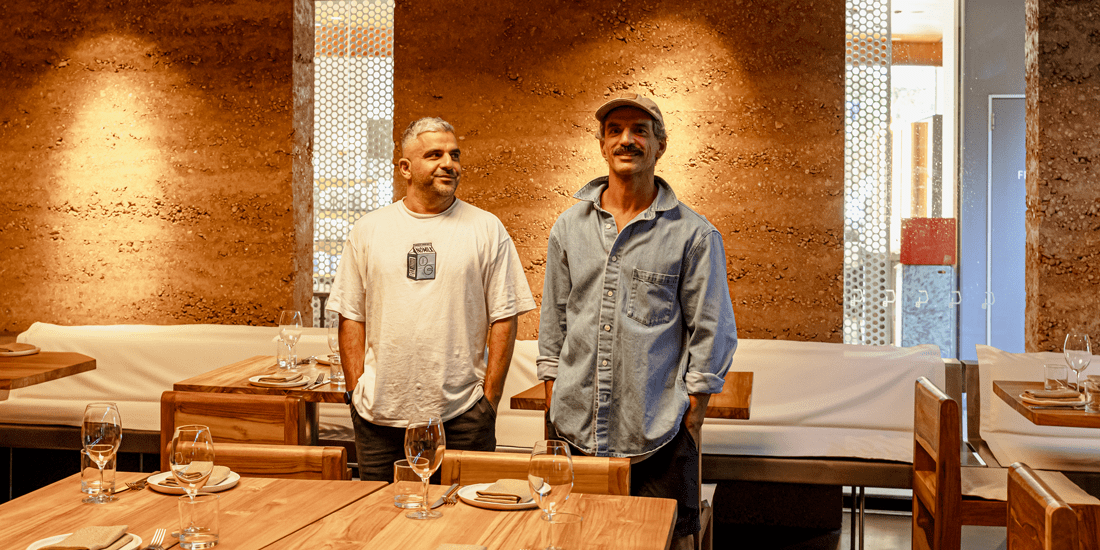
All that said, if there’s one secret to success that the duo will readily agree upon, it’s the impact of collaboration.
Over its 12-year lifespan, Gerard’s has been lucky enough to be shaped by a number of key figures. There’s Salwa, of course. Gerard’s wouldn’t be if not for her influence. Then there’s Gerard’s head chefs, each of which imparted a piece of their own personal creativity into the mixture.
During Ben Williamson’s tenure, Gerard’s first earned its position at the top of Brisbane’s dining pyramid. After Ben moved on to write his own restaurateur story with fire-powered Agnes, custodianship of the Gerard’s kitchen passed to Sydney-born chef Adam Wolfers in 2019, who imbued the Gerard’s menu with influences drawn from his own Jewish heritage and flavours.
Adam saw the restaurant through the choppy seas of the pandemic before the baton was passed again, this time to Gerard’s current executive chef Jimmy Richardson. Under Jimmy, the Gerard’s offering has come full circle, with the menu drawing more heavily on familial influences and a high level of technical ability applied to restaurant’s traditional Levantine-inspired recipes.
The Moubaraks also credit much of their restaurant’s longevity to long-time general manager Judith Hurley, design-centric collaborators like Jared Webb from J.AR OFFICE and the team at James Street Initiative, under whose aegis Gerard’s has continued to thrive, even as the strip as evolved around it. And then there’s the diner, whose custom is the all-important barometer of a restaurant’s success.
“I think our punter, to their core, is a little bit more adventurous and they expect that from us,” says Elie. “We need to think about having a thread that they understand and recognise, but also overdelivering and encouraging them to expect the unexpected from us. And I think we’ve always been like that.”
Johnny draws parallels between his style of service and the creation of a film project – there’s a sense of orchestration at play that sees the restaurant as the scene’s setting, the staff as the crew, the food as the plot and the customers as the central characters.
“The craft of both of them – the spine of hospitality and film are very similar,” says Johnny. “We build a set, we open the door, we set a strong narrative and we entertain. I’m like a director and we’re creating the entertainment. And then you finish, you wrap it up and you shut it all off. It’s very similar, in a way.”
By the end of our chat, it’s clear that the Gerard’s story isn’t close to its conclusion. It’s ever changing, constantly being revised and rewritten from service to service. As far as engaging narratives go, Gerard’s is one that has always held attention.
What does the next chapter hold? In news that will excite those that have been following along from the beginning, Johnny and Elie are eager to venture into new territory.
“You really need to think about hospitality as not just a game that’s bound by this and this,” says Elie, who mentions that a long-term project for the team is to work more with the land and get into organic farming. “There are some peripheral things and vertically integrated things that you can add, and I feel like it’s very experiential now, as opposed to just eating good food and feeling the space.”
For Johnny and Elie, there’s still so much more to say. Plus, it’s unlikely their addiction to the world of hospitality would allow them to sit idle for long, anyway.
“We’ll never be comfortable,” admits Johnny. “We can’t sit on our laurels – that’s part of our DNA and our culture and our behaviour. We can’t do that.”
Head to the Stumble Guide for more info on Gerard’s, including booking info and contact details.
